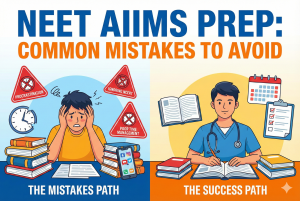Introduction
Analyse mock test results right after you finish a practice exam — it’s the bridge between taking tests and actually improving your score. Many students treat mocks as one-off checks; the difference between average and top performance is how methodically you review your test performance afterward. This guide gives a clear, repeatable process to evaluate your strengths, fix recurring mistakes, and plan targeted practice for school exams, JEE, or NEET.
Why you must review test performance
A focused review turns every mock into a learning opportunity. When you systematically evaluate your test performance, you can:
-
Find high-impact weak topics that cost marks.
-
Distinguish careless lapses from conceptual gaps.
-
Improve pacing by spotting time sinks.
-
Build an exam strategy tailored to your strengths.
Step 1: Analyze Mock Test Results — check overall score and trend
Start with the big picture: your total marks, percentage, and rank if available. Place this mock alongside your last 3–5 mocks to see the trend. If scores are flat or falling, your study routine likely needs a structural change; if you’re rising slowly, keep what’s working and sharpen weaker areas.
Action: Log the score in a spreadsheet with date, test name, and time taken. That log becomes your progress tracker.
Step 2: Review performance topic-wise
Break the paper into subject or chapter buckets (Physics → Mechanics, Electricity; Biology → Ecology, Physiology; Math → Algebra, Calculus). For each bucket record:
-
Questions attempted / total
-
Accuracy (%)
-
Time spent
This helps prioritise — spend more hours on high-weight, low-accuracy topics rather than low-weight ones where you already perform decently.
Step 3: Classify every mistake
Not all errors require the same fix. Tag each wrong answer as one of:
-
Conceptual — revisit theory and basic examples.
-
Procedural / calculation — practice stepwise solutions; drill similar problems.
-
Careless — slow reading, units, sign errors; practice accuracy under pressure.
-
Strategy/time — skipped due to time or bad question order.
For each tag, write a single corrective action (e.g., “relearn Newton’s Laws — 5 solved examples daily” or “practice arithmetic accuracy drills”).
Step 4: Evaluate time management and pacing
From your test log, compute the average time per question and per section. Identify questions that consumed excessive time and why (lengthy algebraic manipulation, unclear concept, slow reading). If time loss is due to technique, learn shortcuts; if it’s conceptual, schedule targeted study sessions.
Action: In the next mock deliberately use a different question order (e.g., do high-confidence questions first) to test improved pacing.
Step 5: Compare with solutions and learn better methods
Go through official solutions or editorial videos. For correct answers, note if your method is optimal; for wrong ones, identify the exact step where you erred. Often you’ll discover faster approaches or common traps — copy those shortcuts into a “tricks & notes” file for quick revision.
Step 6: Build a targeted practice plan from your analysis
After you analyse mock test results, convert insights into a 7-day and 30-day action plan:
-
7-day: Correct the top 3 recurring mistakes; do 2 timed mini-tests.
-
30-day: Master 2 high-weight weak topics with daily micro-practice and weekly mock revisions.
Use active recall and spaced repetition for concepts; solve timed problem sets for speed and endurance.
Step 7: Track and compare — close the loop
Each mock should feed the next: track whether weak areas improve, whether careless mistakes drop, and whether your average time per question falls. If not, change the corrective action — what you planned didn’t work; iterate quickly.
Action: Update your spreadsheet with post-action notes and the next test’s focus points.
Extra tips to make your analysis efficient
-
Use platform analytics: many mock platforms provide topic-wise heatmaps and time distributions — use them.
-
Keep a mistake notebook: Jot down the exact error and the corrected solution for quick review.
-
Simulate exam conditions: Practise full-length mocks under the same constraints as the exam to gauge real stamina.
-
Peer review: Swap tests with a trusted peer to spot blind spots you miss.
-
Stay rested: analyse with a fresh mind — fatigue hides patterns.
FAQ (short)
Q: How often should I take full mocks?
A: For final preparation, aim for 1–2 full mocks per week and brief daily topic tests. Increase frequency if you can manage proper analysis each time.
Q: How long should I spend analysing one mock?
A: 30–60 minutes for a focused review; longer if you plan deep topic relearning. Keep it structured.
Q: Should I always review correct answers?
A: Yes — correct answers can reveal more efficient methods and prevent future careless errors.
Conclusion
A test without analysis is practice without improvement. When you consistently analyse mock test results, prioritise weak topics, fix recurring error types, and refine pacing, your scores will reflect real, measurable gains. Turn each mock into a focused learning cycle, and you’ll reach exam day with proven confidence.
Also Read: Critical Thinking Skills: How to Develop Them in High School







